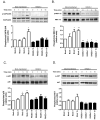Alternatively spliced RAGEv1 inhibits tumorigenesis through suppression of JNK signaling
- PMID: 20570900
- PMCID: PMC2919303
- DOI: 10.1158/0008-5472.CAN-10-0595
Alternatively spliced RAGEv1 inhibits tumorigenesis through suppression of JNK signaling
Abstract
Receptor for advanced glycation end products (RAGE) and its ligands are overexpressed in multiple cancers. RAGE has been implicated in tumorigenesis and metastasis, but little is known of the mechanisms involved. In this study, we define a specific functional role for an alternate splice variant termed RAGE splice variant 1 (RAGEv1), which encodes a soluble endogenous form of the receptor that inhibits tumorigenesis. RAGEv1 was downregulated in lung, prostate, and brain tumors relative to control matched tissues. Overexpressing RAGEv1 in tumor cells altered RAGE ligand stimulation of several novel classes of genes that are critical in tumorigenesis and metastasis. Additionally, RAGEv1 inhibited tumor formation, cell invasion, and angiogenesis induced by RAGE ligand signaling. Analysis of signal transduction pathways underlying these effects revealed marked suppression of c-jun-NH(2)-kinase (JNK) pathway signaling, and JNK inhibition suppressed signaling through the RAGE pathway. Tumors expressing RAGEv1 were significantly smaller than wild-type tumors and displayed prominently reduced activation of JNK. Our results identify RAGEv1 as a novel suppressor, the study of which may offer new cancer therapeutic directions.
Copyright 2010 AACR.
Figures






Similar articles
-
Alternative splicing of the RAGE cytoplasmic domain regulates cell signaling and function.PLoS One. 2013 Nov 8;8(11):e78267. doi: 10.1371/journal.pone.0078267. eCollection 2013. PLoS One. 2013. PMID: 24260107 Free PMC article.
-
Alternative splicing of RAGE: roles in biology and disease.Front Biosci (Landmark Ed). 2011 Jun 1;16(7):2756-70. doi: 10.2741/3884. Front Biosci (Landmark Ed). 2011. PMID: 21622207 Review.
-
Inhibitory effect of alternatively spliced RAGEv1 on the expression of NF-kB and TNF-α in hepatocellular carcinoma cells.Genet Mol Res. 2012 Jun 29;11(2):1712-20. doi: 10.4238/2012.June.29.3. Genet Mol Res. 2012. PMID: 22843047
-
The amphoterin (HMGB1)/receptor for advanced glycation end products (RAGE) pair modulates myoblast proliferation, apoptosis, adhesiveness, migration, and invasiveness. Functional inactivation of RAGE in L6 myoblasts results in tumor formation in vivo.J Biol Chem. 2006 Mar 24;281(12):8242-53. doi: 10.1074/jbc.M509436200. Epub 2006 Jan 9. J Biol Chem. 2006. PMID: 16407300
-
Activation of receptor for advanced glycation end products: a mechanism for chronic vascular dysfunction in diabetic vasculopathy and atherosclerosis.Circ Res. 1999 Mar 19;84(5):489-97. doi: 10.1161/01.res.84.5.489. Circ Res. 1999. PMID: 10082470 Review.
Cited by
-
Targeted nanoparticles for multimodal imaging of the receptor for advanced glycation end-products.Theranostics. 2018 Dec 1;8(22):6352-6354. doi: 10.7150/thno.31515. eCollection 2018. Theranostics. 2018. PMID: 30613302 Free PMC article.
-
Alternative splicing of the RAGE cytoplasmic domain regulates cell signaling and function.PLoS One. 2013 Nov 8;8(11):e78267. doi: 10.1371/journal.pone.0078267. eCollection 2013. PLoS One. 2013. PMID: 24260107 Free PMC article.
-
Apoptosis, autophagy, necroptosis, and cancer metastasis.Mol Cancer. 2015 Feb 21;14:48. doi: 10.1186/s12943-015-0321-5. Mol Cancer. 2015. PMID: 25743109 Free PMC article. Review.
-
Mouse RAGE Variant 4 Is a Dominant Membrane Receptor that Does Not Shed to Generate Soluble RAGE.PLoS One. 2016 Sep 21;11(9):e0153657. doi: 10.1371/journal.pone.0153657. eCollection 2016. PLoS One. 2016. PMID: 27655067 Free PMC article.
-
Molecular Characteristics of RAGE and Advances in Small-Molecule Inhibitors.Int J Mol Sci. 2021 Jun 27;22(13):6904. doi: 10.3390/ijms22136904. Int J Mol Sci. 2021. PMID: 34199060 Free PMC article. Review.
References
-
- Hanahan D, Weinberg RA. The hallmarks of cancer. Cell. 2000 Jan 7;100(1):57–70. - PubMed
-
- Taguchi A, Blood DC, del Toro G, Canet A, Lee DC, Qu W, et al. Blockage of RAGE-amphoterin signalling suppresses tumour growth and metastases. Nature. 2000;405:354–60. - PubMed
-
- Logsdon CD, Fuentes MK, Huang EH, Arumugam T. RAGE and RAGE ligands in cancer. Curr Mol Med. 2007 Dec;7(8):777–89. - PubMed
Publication types
MeSH terms
Substances
Grants and funding
LinkOut - more resources
Full Text Sources
Research Materials
Miscellaneous

